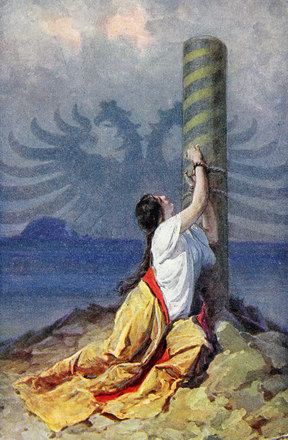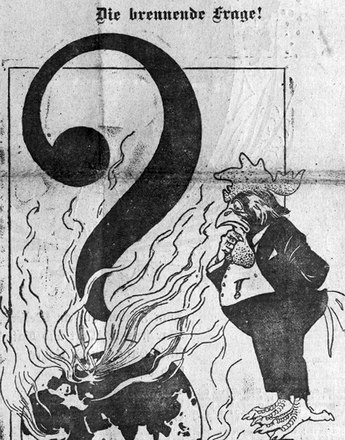The aim of state independence: from Utopia to a programme for the masses
The loss of authority in the organs of government happened at breakneck speed (particularly in the sight of the failure to provide for people’s everyday needs) and created a vacuum into which the advocates of Czech state independence could penetrate. This originally avant-gardist idea became a feasible option for more and more people as the year 1918 wore on.
On 6 January 1918, a delegation of Czech Imperial Council members met several Slovakian representatives in order to make a joint declaration on the future of the nation. This was a reaction to Wilson’s Fourteen Point Programme, according to which the peoples of Austria-Hungary should be granted “the freest opportunity for autonomous development”.
This Three Kings Day Declaration demanded the right of national self-determination of the Czechs and Slovaks with the perspective of forming a Czechoslovakian State within the framework of the Habsburg Monarchy. This foundational paper was at first confiscated by the Imperial-Royal authorities but released later for publication.
The Imperial Government, fully aware of the explosive development in Prague, plied a cautious approach, but could not prevent the demands assuming a more radical form. An ever greater proportion of the Czech public committed themselves to the aims of the political exiles surrounding Masaryk – total independence and the disintegration of the Habsburg Monarchy.
Actions of solidarity were organised by artists and intellectuals advocating the fight for the “national cause”. In May 1918 spontaneous demonstrations flared up during the festivities celebrating the Diamond Jubilee of the Prague National Theatre; cries re-echoed such as “Long live Wilson, long live Masaryk”. Although the demonstrations were quickly quenched by the police, it was obvious that the originally extremist minority position advocating state autonomy had reached the masses.
The mouthpiece of the domestic separatist movement materialised on 13 July 1918: the Czechoslovakian National Committee (Československý národní výbor), unifying politicians of the most diverse loyalties. Despite the designation “Czechoslovakian”, this was de facto a national committee of Czechs – not a single Slovak was represented. It embodied the Czechs’ “Bohemocentric” interpretation of the concept of Czechoslovakian movement.
A prominent politician of the National Democratic Constitutional Party, Karel Kramář, was elected president. Kramář had been charged with high treason in 1915 and condemned to death. The judgement was never executed, and Kramář was freed in the amnesty of Emperor Karl in 1917.
The Czechoslovakian National Committee was the first organ of this kind in Austria-Hungary. Its constitution was accepted by Government authorities in order to avoid an exacerbation of the situation, thus giving the Czech ambitions for independence a new platform. During the summer these were supported in addition by political forces that had hitherto shown loyalty to the Habsburg Monarchy, including the clerical and Christian Socialist parties.
Translation: Abigail Prohaska
Bihl, Wolfdieter: Der Erste Weltkrieg 1914–1918. Chronik – Daten – Fakten, Wien/Köln/Weimar 2010
Hoensch, Jörg K.: Geschichte Böhmens. Von der slavischen Landnahme bis ins 20. Jahrhundert, München 1987
Křen, Jan: Dvě století střední Evropy [Zwei Jahrhunderte Mitteleuropas], Praha 2005
Kučera, Rudolf: Muži října 1918. Osudy aktérů vzniku Republiky Československé [Die Männer des Oktobers 1918. Schicksale der Akteure der Entstehung der Tschechoslowakischen Republik], Praha 2011
Šedivý, Ivan: Češi, České země a velká válka 1914–1918 [Die Tschechen, die Böhmischen Länder und der Große Krieg 1914–1918], Praha 2001
-
Chapters
- Delenda Austria – Austria must be destroyed!
- The aim of state independence: from Utopia to a programme for the masses
- Preparing for the Coup
- The Day of the Coup: 28 October 1918
- The Founding of Czechoslovakia
- The Czechoslovakian Republic as Successor State to Austria-Hungary
- The Czechoslovakian Legions
- The Fall of the Symbols of Habsburg Rule




